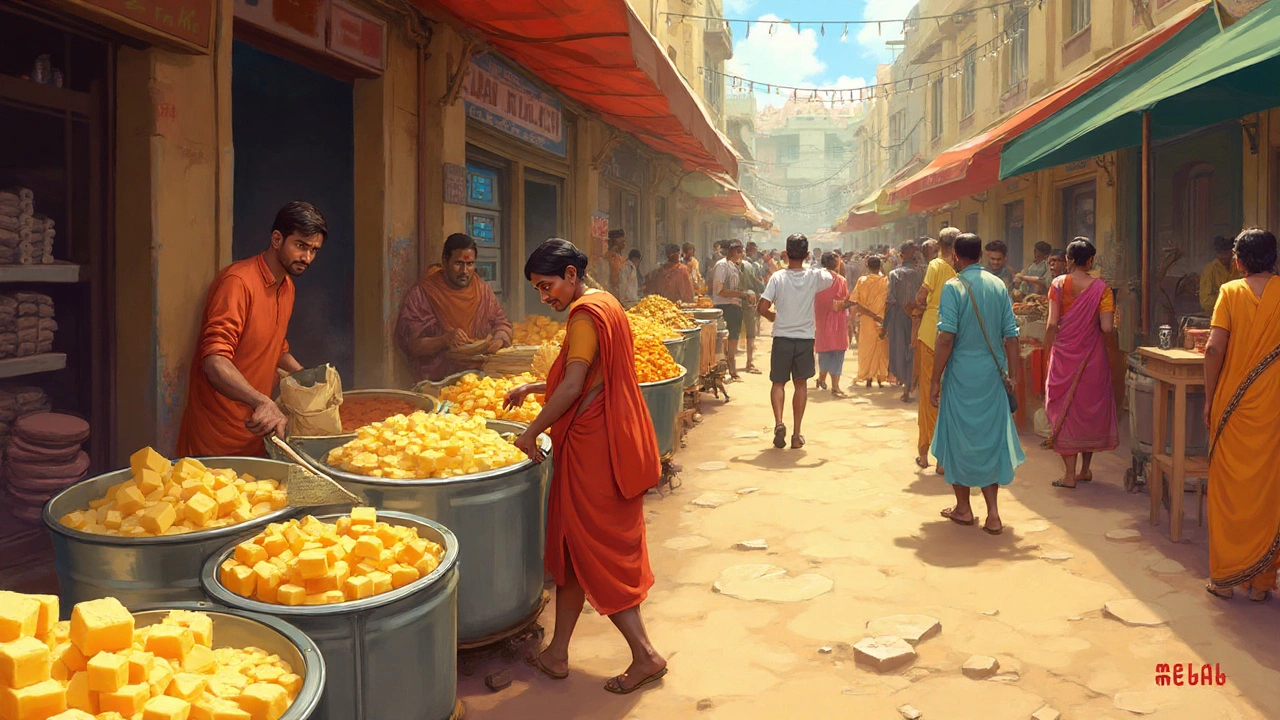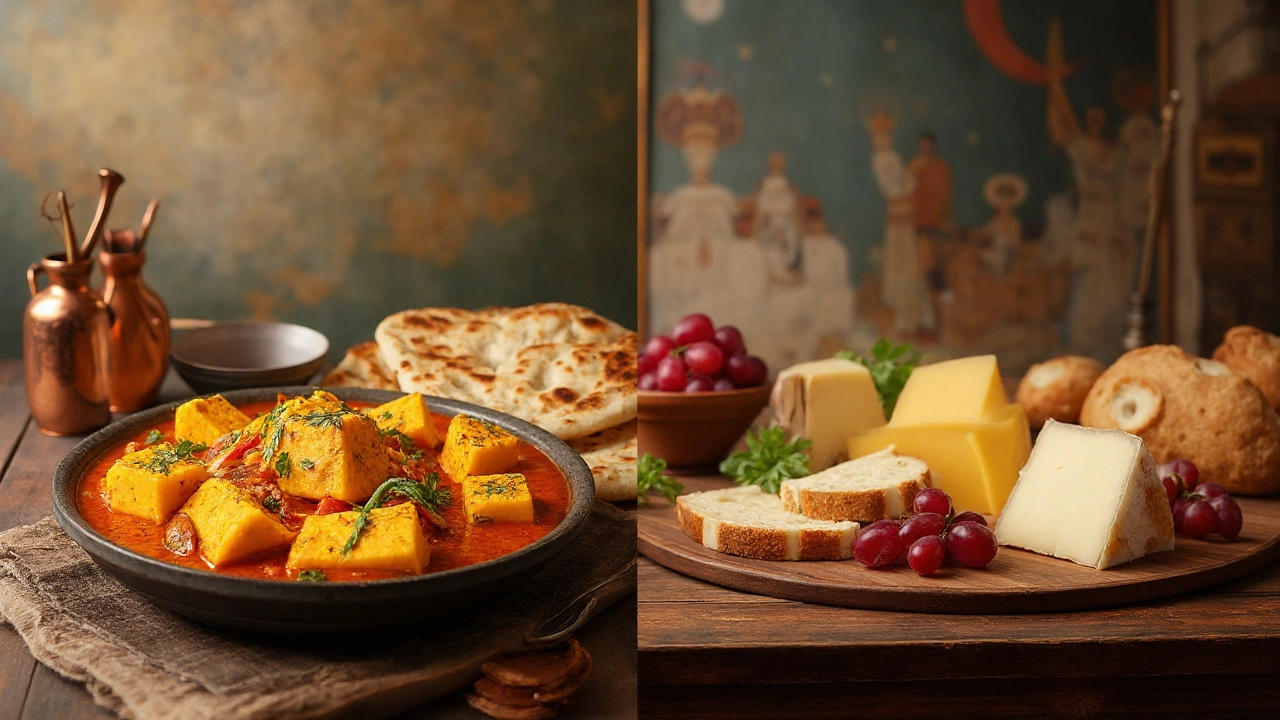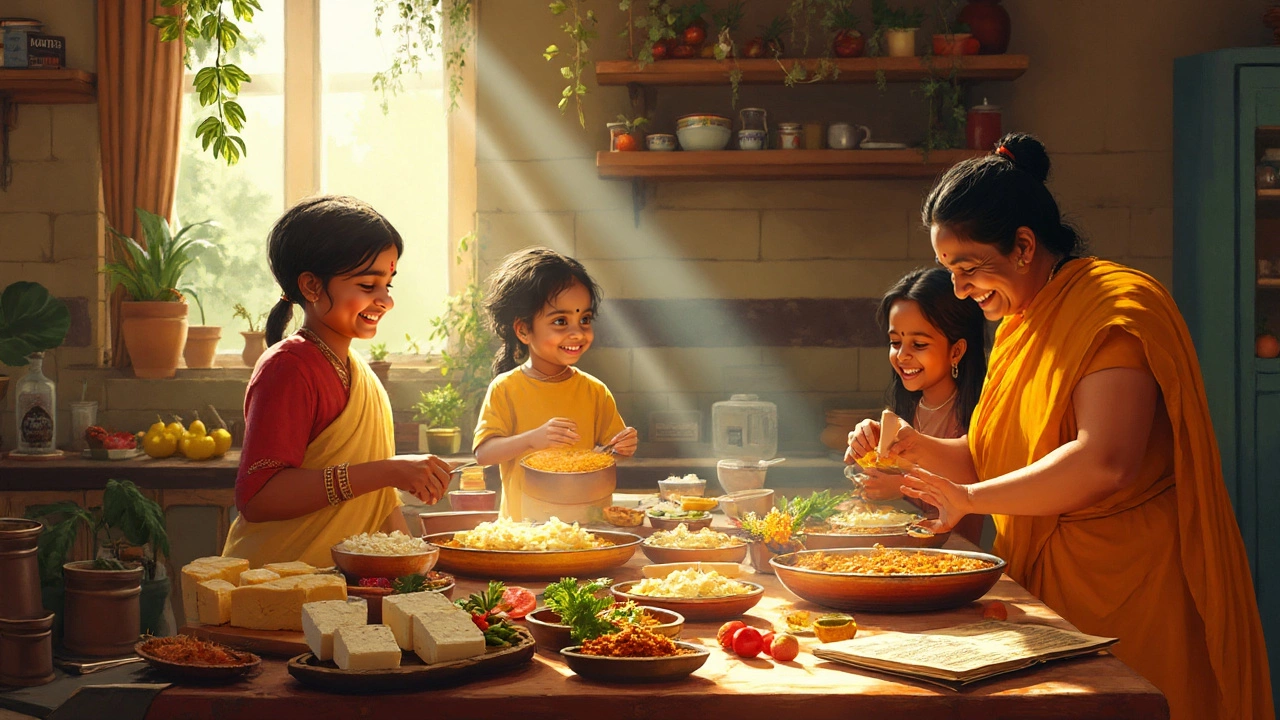You could travel through every spice-scented corner of India and barely spot a wedge of Cheddar or Brie. Walk through the loud, colorful markets, and you’ll see baskets of paneer but nothing that looks remotely like European cheese. This isn’t just one of those things that hasn’t caught on yet—it’s almost a culinary blind spot, and it’s not for lack of cows or dairy traditions. So what’s up with cheese’s invisible presence in Indian kitchens? It’s not just about taste or choice. There’s way more to the story—centuries of cultural food rules, clever workarounds, and some pretty unique attitudes to dairy that have kept cheese on the outside looking in. Ready to find out why ghee, curd, and paneer dominate the scene, while Cheddar barely gets an invite?
How Indian Food Culture Shapes What’s on the Plate
Food isn’t just fuel in India—it’s an intimate piece of family, religion, and region. Ask any grandparent and you’ll hear about recipes that have been passed down for generations, each one with a story attached. Unlike in Europe or North America, where cheese is almost a daily staple, that’s never quite happened in India. Walk through a typical North Indian kitchen, and you’ll spot a stack of rotis, a pot of lentils, a tub of fresh curd, maybe even some homemade paneer. But there’s no cheese grater in sight. Why?
Dairy is sacred in India, but it takes on a different personality. Cows, venerated in Hinduism, mean butter, ghee, buttermilk, yogurt, and, of course, paneer are everywhere. But the culture has steered clear from rennet-based cheeses, probably for religious reasons—rennet is an enzyme from animal stomachs and most cheese outside India uses it. The idea of letting milk ferment and rot—that’s how some cheese matures—just isn’t in line with local ideas about purity and satvik (pure) foods. Most traditional Indian food avoids anything aged, fermented, or considered “live.”
Regional cuisines double down on this. South India leans on coconut and lentils, with dairy making occasional guest appearances (especially in desserts). Even in North India, where you do see things like lassi, ghee, milk sweets, and paneer, cheese hasn’t found much ground. There’s just not much call for that funky, salty, or moldy taste that cheese brings. Indians love fresh flavors and bold spices—the gentle sourness of curd and the squeaky blandness of paneer fit right in, but tangy blue cheese or the nuttiness of Gruyère? Not so much.
Here’s something fascinating as well: the climate. Cheese, especially the types that transform into aged masterpieces, thrives in cool, dry environments. India’s steamy summers and high humidity turn cheese making into a real gamble. A slab of Camembert? It’d collapse into goo before it even had time to ripen. There are exceptions—Kashmir’s kalari cheese, for example, and hill station cheeses in places like Ooty and Coonoor—but they’re the rare outliers.
Plus, there’s the king of Indian dairy: paneer. It’s not cheesy in that classic sense—it’s just curdled milk set with some acid—but boy, is it popular. It’s fresh (made in hours), has no animal rennet, and soaks up flavor like nothing else. You can toss it into curry, grill it, stuff it, fry it. Try that with a wedge of Roquefort—it would just melt into a puddle! Paneer simply fits the cooking style, the flavors, and the values. Other cheeses just seem out of step.
It’s funny—other classic dairy products, from Italian mascarpone to Greek feta, are getting more hype recently in India’s bigger cities, but in day-to-day meals, cheese is still an outsider. Restaurants might sprinkle some mozzarella on pizzas, and gourmet shops in Mumbai or Delhi could carry a few European cheeses these days, but it isn’t yet a mainstay in home kitchens or traditional celebrations. Even brands like Amul, which started making cheese in the 1940s, mainly marketed it for “Western-style” foods or export. Cheese on a paratha? Still pretty rare outside chain cafes.
So, for now, Indian cuisine keeps cheese at arm’s length. It’s fresh, mild, and milky flavors or nothing, with spices doing the heavy lifting. Paneer wins the popularity contest, hands down.
| Dairy Product | Popularity in India | Typical Use |
|---|---|---|
| Paneer | Very High | Curry, Snacks, Sweets |
| Curd (Yogurt) | Extremely High | Side dish, Cooking, Drinks |
| Cheese | Low | Fast food, Pizza, Sandwiches |
| Ghee | High | Cooking, Sweets |
| Butter | Moderate | Spread, Cooking |

Historical Reasons: Why Cheese Never Became “Ours”
Cultural tastes don’t just pop up out of the blue—they’re shaped by history, migration, even trade routes. If you’re wondering why cheese never got that “nostalgic food” status in India, you’ve got to look at how cuisine evolved over centuries. While European monks fussed over their wheels of Parmeggiano and French farmers perfected Camembert, Indian dairies were churning fresh curd and ghee, with barely a glance at aging wheels.
Let’s start nearly 5,000 years back. The Indus Valley Civilization probably had dairy, but it was mainly about fresh milk, yogurt, and clarified butter. By the time the Vedic scriptures took root (around 1500 BCE), dairy had become intertwined with religious rituals, births, and deaths—offering ghee to the gods, spooning curd at weddings. There’s no mention of anything close to hard cheese, and no evidence the process moved east with Indo-European migration.
How about foreign influences? India has had epic encounters with the outside world. When the Mughals rolled in, they brought North Persian and Turkish styles, but their dairy fix was rich sweets, not cheese. Europeans—the Portuguese, French, Dutch, and British—did bring cheese, but usually for their own tables or for colonial establishments. You won’t find 18th-century maharajas chomping on Cheddar. Even when Europeans introduced “Western” cheese to big Indian cities in the colonial era, it never became an everyday thing. Sure, a handful of clubs and railway hotels stocked cheese and crackers, but they rarely nudged their way into home kitchens.
Part of the reason: infrastructure. Before refrigeration became common in the 20th century, preserving cheese in the Indian climate made it tricky. Cheese making is a “live” thing—you need to manage bacteria, enzymes, humidity, and temperature. In the monsoon swelter, cheese could go wrong (read: inedible) really fast. People simply stuck to forms of dairy that were lower risk—curd, paneer, ghee. You can make these at home, eat them right away, no surprise funky flavors or odors to worry about.
Modern times saw attempts to bring cheese into the fold. Brands like Amul in Gujarat (launched in 1946) tried to popularize processed cheese. It got some traction mainly for sandwiches and as pizza topping, but most families viewed it as a foreign, “special” food—nice for kids’ tiffin now and then, not something to be eaten with rice or dal. International-style cheeses—mozzarella, gouda, processed cheese slices—are often imported or made locally for restaurant chains, not home cooks. The market size for cheese in India is much smaller compared to paneer, curd, and ghee, according to industry reports. For example, a 2023 market survey by IMARC Group estimated paneer sales at five times that of cheese in urban areas and nearly ten times in smaller towns.
Another thing that’s shaped cheese’s fate is simple daily rhythms. Indian cooking usually involves freshly made food, eaten hot. Cheese, unless super fresh, is almost always aged to some degree. The act of fermenting something on purpose and waiting weeks or months before eating it? That’s not a comfort zone for most Indian kitchens. Even bread is mostly flatbreads like chapati or dosa—quick, fresh, simple—compared to crusty loaves that go wonderfully with a slice of aged cheese.
If you look at Indian festivals and big life events—weddings, birthdays, religious ceremonies—you’ll find flour, lentils, rice, milk, sugar, and tons of ghee and paneer. Cheese just never made the invite list; it was never part of ritual offerings, nor did it show up in sweets. That deep cultural link to dairy isn’t missing, but cheese just didn’t fit the spiritual or communal role expected from food.
There’s also a practical reason. Home cheese-making can get complicated: finding the right cultures, maintaining hygiene, waiting weeks for flavor to bloom—not super practical for households used to quick, everyday recipes. Paneer wins again because it’s ready in under an hour. That’s a big deal in busy kitchens, especially outside metro cities, where hustling through three meals every day isn’t a choice; it’s reality.
Some exceptions? Regional cheese-like foods exist. Kashmir has kalari (sometimes called “the mozzarella of Jammu”) that’s fried until crisp outside, stretchy inside. Goan cuisine features chhena, which is closer to ricotta. In the Nilgiris (hill towns like Ooty and Coonoor), you’ll find small dairies making European cheeses, but they cater mostly to tourists and expats. These outliers prove that cheese can thrive in the right microclimate and with enough local love, but they’re still rare compared to the pan-Indian love for ghee and paneer.

Modern Trends: The New Faces of Cheese in Indian Kitchens
Step into an Indian supermarket in 2025 and, sure, you might see more cheese than your grandma ever did. Queues of gooey mozzarella for pizzas, neat packs of shredded cheddar, and even some quirky samples of feta and gouda, especially in the big cities. But that doesn’t mean cheese has “gone mainstream.” It’s still a niche, a treat, a foreign cousin that visits at parties and fast-food stops but rarely moves in for good.
Young, urban Indians have way more exposure to global foods than their parents did. Netflix food documentaries, Instagram foodies, and easy online imports are rewriting the rules. When Domino’s came to India in the 1990s and Big Bazaar started stocking cheese slices, kids started seeing cheese as cool and international. But it’s almost always linked to “special” foods—pizza, burgers, stuffed cheese parathas at hip cafes—not basic dal-chawal or roti-sabzi at home. Even today, if you order a dosa, it’s probably either traditional or “with cheese” as a fusion twist, not because cheese is genuinely beloved in the typical household kitchen.
The influence of food bloggers, celebrity chefs, and global TV food shows has given artisan cheese makers new room to grow. Now you’ll find small dairies in the Himalayan foothills making stellar Gouda, or European expats teaching local farmers to age cheddar in the hills above Pune. Big metro cities have cheese clubs, fancy cheese platters at five-star hotels, and “Wine and Cheese” events that are super Instagrammable. These cheeses often come with a hefty price tag, so they don’t land on the everyday shopping list. For most families, cheese is still more “fun extra” than essential.
There’s more, though. Modern diets in India are paying more attention to protein, healthy fats, and “superfoods.” Cheese has started to get a re-appraisal—rich in protein, calcium, and fats. Some new home cooks experiment with cheese not just for Western-style recipes, but fusion dishes: think chili cheese dosa, cheese-stuffed kulcha, or masala mac and cheese. Kids raised in cities might even ask for cheese cubes in their lunchboxes right alongside the old standby—paneer sandwiches.
Still, cheese faces old hurdles. About 70% of Indians are lactose intolerant in some form, according to a 2022 survey by the Indian Council of Medical Research. Fresh cheeses like paneer and curd are low-lactose thanks to the way they’re made, but aged cheese is a different story. This keeps hard, aged cheeses out of the happy everyday food bracket for lots of people, especially older adults.
If you’re curious about which Indian city eats the most cheese, here’s a fun fact: Mumbai, Delhi, and Bangalore consume 80% of all cheese sold in the country, mostly on pizzas, sandwiches, and snacks according to a 2024 market analysis by Nielsen India. But even there, cheese lags far behind humble paneer or curd.
For folks wanting to experiment at home, making paneer is almost a rite of passage. But turning out a homemade Gouda takes patience, special bacteria, climate control, and time. Most just don’t bother, unless it’s a fun weekend project. Here are a few tips if the cheese bug has bitten you:
- Start with ricotta or queso fresco—these are fast and forgiving, just like paneer.
- If you live in a warm, humid place, use a clean air-conditioned room for aging experiments.
- Try cheese blends made locally—they’re adapting better to Indian tastes and climates each year.
- Always read labels—processed cheeses might have more salt and additives than you expect.
- Paneer, chhena, and kalari are fantastic if you want a “cheese-like” hit without the fuss.
Will cheese ever become as big as paneer in India? Who knows. If it ever does, it’ll be because Indian cooks adapt it in wildly creative ways, not because anyone tries to copy French or Italian food culture. Until then, the heart (and lunchbox) belongs to paneer, curd, and ghee—loyal, familiar, a little unglamorous, and absolutely beloved.
